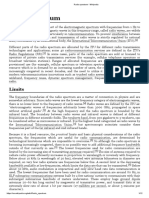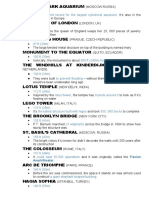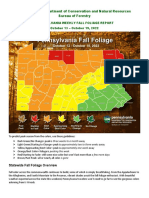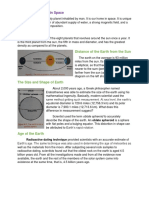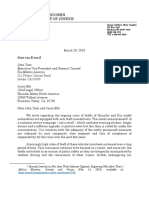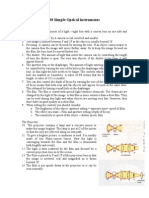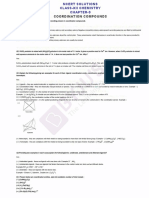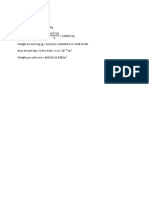0 ratings0% found this document useful (0 votes)
65 viewsTornados
Tornados
Uploaded by
Roberto LópezTornados are short-lived rotating columns of air that extend from thunderstorms to the ground. The most intense tornados form from supercell thunderstorms requiring the right conditions. The deadliest tornado on record was the 1989 Bangladesh tornado that killed 1,300 people and destroyed the towns of Daulatpur and Saturia. The deadliest US tornado was the 1925 "Tri-State" tornado that crossed Missouri, Illinois, and Indiana, killing over 700 people with winds up to 352 km/h over a path of 377 km. Effective emergency plans are needed to prepare for intense tornados.
Copyright:
© All Rights Reserved
Available Formats
Download as PPTX, PDF, TXT or read online from Scribd
Tornados
Tornados
Uploaded by
Roberto López0 ratings0% found this document useful (0 votes)
65 views9 pagesTornados are short-lived rotating columns of air that extend from thunderstorms to the ground. The most intense tornados form from supercell thunderstorms requiring the right conditions. The deadliest tornado on record was the 1989 Bangladesh tornado that killed 1,300 people and destroyed the towns of Daulatpur and Saturia. The deadliest US tornado was the 1925 "Tri-State" tornado that crossed Missouri, Illinois, and Indiana, killing over 700 people with winds up to 352 km/h over a path of 377 km. Effective emergency plans are needed to prepare for intense tornados.
Copyright
© © All Rights Reserved
Available Formats
PPTX, PDF, TXT or read online from Scribd
Share this document
Did you find this document useful?
Is this content inappropriate?
Tornados are short-lived rotating columns of air that extend from thunderstorms to the ground. The most intense tornados form from supercell thunderstorms requiring the right conditions. The deadliest tornado on record was the 1989 Bangladesh tornado that killed 1,300 people and destroyed the towns of Daulatpur and Saturia. The deadliest US tornado was the 1925 "Tri-State" tornado that crossed Missouri, Illinois, and Indiana, killing over 700 people with winds up to 352 km/h over a path of 377 km. Effective emergency plans are needed to prepare for intense tornados.
Copyright:
© All Rights Reserved
Available Formats
Download as PPTX, PDF, TXT or read online from Scribd
Download as pptx, pdf, or txt
0 ratings0% found this document useful (0 votes)
65 views9 pagesTornados
Tornados
Uploaded by
Roberto LópezTornados are short-lived rotating columns of air that extend from thunderstorms to the ground. The most intense tornados form from supercell thunderstorms requiring the right conditions. The deadliest tornado on record was the 1989 Bangladesh tornado that killed 1,300 people and destroyed the towns of Daulatpur and Saturia. The deadliest US tornado was the 1925 "Tri-State" tornado that crossed Missouri, Illinois, and Indiana, killing over 700 people with winds up to 352 km/h over a path of 377 km. Effective emergency plans are needed to prepare for intense tornados.
Copyright:
© All Rights Reserved
Available Formats
Download as PPTX, PDF, TXT or read online from Scribd
Download as pptx, pdf, or txt
You are on page 1of 9
Tornados
By: Roberto López Thomas and Adán Esteban Mandujano Pérez
Definition
A tornado is a mass of air with high angular velocity whose lower end
is in contact with the Earth's surface and the upper end with a cloud.
It is the most energy-dense cyclonic atmospheric phenomenon on
Earth. However, unlike, for example, cyclones or typhoons, it is short-
lived and short-lived. It can vary from seconds to more than an hour.
How tornadoes form?
The most intense tornadoes emerge
from what are called supercell
thunderstorms. For such a storm to
form, first "you need the ingredients
for a regular thunderstorm to form.
Daulatpur and Saturia tornado
The devastation was so great that, except for the skeletons of trees, there was no sign of
permanent infrastructure". This is how the Bangladesh Observer described the catastrophe of the
tornado that hit the towns of Daulatpur and Saturia.
In fact, an area of six square kilometers was totally devastated. It is the deadliest of all tornadoes
on record, with a death toll of 1,300.
It occurred on April 26, 1989, after a six-month period of drought that probably created the
conditions for the spectacular storm to occur.
Nearly 80,000 people lost their homes and the towns of Daulatpur and Saturia were totally
destroyed. The magnitude of the tornado on the Fujita scale is unknown, due to the lack of means
to make measurements.
Comparatives
“Tri-State” tornado
This is the name given to the deadliest tornado in the history of the United States and the third deadliest in the
world. It occurred on Wednesday, March 18, 1925. Its geographical scope was, as its name indicates, that of three
states: Missouri, Illinois and Indiana.
The tornado killed more than twice as many people as the second deadliest tornado in the United States, the Great
Natchez, which occurred in 1840. Winds of up to 352 kilometers per hour were recorded.
In its path it traveled from southeast Missouri to southern Illinois and from there to southwest Indiana. Although the
U.S. Weather Service, NOAA, has not qualified it as such, it is recognized by most experts as a category F5
tornado, the highest category.
There are doubts as to whether it was a single tornado or multiple tornadoes. However, some investigations carried
out after the event suggest that it could have been a single tornado and that its path would have reached 377
kilometers in distance.
Comparatives
Emergency plan
Thanks for your atention!
You might also like
- Lindsay Adler Photography Softbox Lighting GuideDocument92 pagesLindsay Adler Photography Softbox Lighting Guide5shwvdmwjkNo ratings yet
- A2 NMR Spectroscopy Mini Mock PDFDocument22 pagesA2 NMR Spectroscopy Mini Mock PDFkasimNo ratings yet
- New Age Heist No-Brainer Ruling The Metaverse: Taliban Steps Up Push As US and UK Send Troops To Evacuate StaffDocument18 pagesNew Age Heist No-Brainer Ruling The Metaverse: Taliban Steps Up Push As US and UK Send Troops To Evacuate StaffJoseAntonioAmadorPérezNo ratings yet
- 1994 - Daily - Bankruptcy and Corporate Governance The Impact of Board Composition and StructureDocument16 pages1994 - Daily - Bankruptcy and Corporate Governance The Impact of Board Composition and Structureahmed sharkasNo ratings yet
- Radio Spectrum - WikipediaDocument12 pagesRadio Spectrum - WikipediaMubashir AliNo ratings yet
- Essay 4.Document5 pagesEssay 4.Nixaly MendezNo ratings yet
- Hydraulic Brake Power-Assist SystemsDocument56 pagesHydraulic Brake Power-Assist Systemsmewiw shortNo ratings yet
- Ceylinco Life Insurance Limited: Mortgage Protection Application(s) - MR G.H.M.I.S PereraDocument1 pageCeylinco Life Insurance Limited: Mortgage Protection Application(s) - MR G.H.M.I.S PereraIshara Sanjeewa PereraNo ratings yet
- Zap Xebra Vehicle Electrical Repair and Troubleshooting PDFDocument14 pagesZap Xebra Vehicle Electrical Repair and Troubleshooting PDFCristy EashNo ratings yet
- Summative Test Permutation, CombinationDocument1 pageSummative Test Permutation, CombinationRomeo Jr Pacheco Opena0% (2)
- 1zua 5670-200 enDocument10 pages1zua 5670-200 enSURJIT SINGHNo ratings yet
- Three Variable SolutionDocument8 pagesThree Variable Solutionmech_lalit2k77856No ratings yet
- 2018 Diesel TOYOTA Jun11Document90 pages2018 Diesel TOYOTA Jun11eko sulistyo80% (5)
- Presentation2 BCMDocument10 pagesPresentation2 BCMvijay palNo ratings yet
- Extreme Wind Events Hurricanes and TornadoesDocument6 pagesExtreme Wind Events Hurricanes and TornadoesallenNo ratings yet
- History of The Solar System EventsDocument18 pagesHistory of The Solar System EventsItz RamNo ratings yet
- Fastest Cars in The WorldDocument6 pagesFastest Cars in The WorldAnand RajNo ratings yet
- Hurricane Katrina at Peak Strength On August 28, 2005Document1 pageHurricane Katrina at Peak Strength On August 28, 2005Eduardo Reyes TorresNo ratings yet
- Solar RadiationDocument37 pagesSolar RadiationMarshet MulatNo ratings yet
- Final Report Grid DisturbanceDocument129 pagesFinal Report Grid DisturbanceLora BishopNo ratings yet
- The Tallest Building ComparisonDocument6 pagesThe Tallest Building ComparisonTrina SambasNo ratings yet
- Ciclo Regular De: BoletínDocument30 pagesCiclo Regular De: BoletínGiordi Sifuentes UribeNo ratings yet
- Back To The PresentDocument15 pagesBack To The PresentMichaela Joice BalayanNo ratings yet
- THE INDEPENDENT Issue 537 Sept 2018Document48 pagesTHE INDEPENDENT Issue 537 Sept 2018The Independent Magazine100% (1)
- Week 3 DCNR Fall Foliage Report 2022Document11 pagesWeek 3 DCNR Fall Foliage Report 2022Avery Van EttenNo ratings yet
- Climate - The Given ConditionsDocument35 pagesClimate - The Given ConditionsKAMAL S. TOMARNo ratings yet
- Ebook DOZEROAOS10Kdeseguidores 2021Document60 pagesEbook DOZEROAOS10Kdeseguidores 2021CamilaBruschNo ratings yet
- Mount ST Helens-Adams Coordination Plan - Final Oct 2014Document36 pagesMount ST Helens-Adams Coordination Plan - Final Oct 2014David HallNo ratings yet
- UPC Estimates Dec2022Document8 pagesUPC Estimates Dec2022Spectrum MediaNo ratings yet
- Summoning Osean FederationDocument128 pagesSummoning Osean FederationRadja RadjaNo ratings yet
- PPTDocument34 pagesPPTPuneet mishra100% (1)
- Terms and Conditions 27 06 PDFDocument4 pagesTerms and Conditions 27 06 PDFShreyash NaikwadiNo ratings yet
- LatinoJustice Opposes HUD Rule Change That Could Make 25k Mixed Status Families HomelessDocument8 pagesLatinoJustice Opposes HUD Rule Change That Could Make 25k Mixed Status Families HomelessLatinoJusticeNo ratings yet
- FormalitiesDocument41 pagesFormalitiesAmmara ShahidNo ratings yet
- WSJ 2021.12.15Document38 pagesWSJ 2021.12.15Rodrigo MunozNo ratings yet
- Criticism of Tesla, Inc. - WikipediaDocument47 pagesCriticism of Tesla, Inc. - WikipediaSer PaNo ratings yet
- Agreements For Net Metering, Net Accounting, Net PlusDocument31 pagesAgreements For Net Metering, Net Accounting, Net PlusNh Chuminda YapaNo ratings yet
- Tabla Periódica Mujeres CientíficasDocument119 pagesTabla Periódica Mujeres CientíficasIrene RoRuNo ratings yet
- Thursday, May 14, 2015 (MTE Daily Issue)Document26 pagesThursday, May 14, 2015 (MTE Daily Issue)The Myanmar TimesNo ratings yet
- Page 273 - 281Document11 pagesPage 273 - 28105 陳宗榮 RYAN GERALD CHUANo ratings yet
- Variable Diameter Rotor StudyDocument212 pagesVariable Diameter Rotor StudyNathan D'SouzaNo ratings yet
- AIAC Guide 2015 LR PDFDocument294 pagesAIAC Guide 2015 LR PDF이민우No ratings yet
- Transpiration For Amateur GardernersDocument3 pagesTranspiration For Amateur Gardernerssurya sureshNo ratings yet
- Artificial Intelligence Demystified: Economic Commission For EuropeDocument38 pagesArtificial Intelligence Demystified: Economic Commission For EuropeSalma SweetNo ratings yet
- Solar & Energy Saving Products PDFDocument333 pagesSolar & Energy Saving Products PDFEl PiamontesNo ratings yet
- NASA: 182972main Mars-PhoenixDocument2 pagesNASA: 182972main Mars-PhoenixNASAdocumentsNo ratings yet
- Introduction 1Document16 pagesIntroduction 1Stefen StrangeNo ratings yet
- AG Letter To Hyundia and KiaDocument8 pagesAG Letter To Hyundia and KiaCory SmithNo ratings yet
- Taksasi Motor 2023 (Update Mei)Document20 pagesTaksasi Motor 2023 (Update Mei)nusa pwkNo ratings yet
- CYHMDocument18 pagesCYHMGFNo ratings yet
- Any Four Black Men Will Do - Rape, Race, and The Ultimate ScapegoatDocument38 pagesAny Four Black Men Will Do - Rape, Race, and The Ultimate ScapegoatBangtan SonyeodanNo ratings yet
- World Nuke MapDocument1 pageWorld Nuke MappbordeauNo ratings yet
- The Loss of BiodiversityDocument2 pagesThe Loss of BiodiversityarpitaNo ratings yet
- Phipps-Conservatory 1994Document2 pagesPhipps-Conservatory 1994gego2No ratings yet
- Palm IslandsDocument2 pagesPalm IslandsAprisa PutriNo ratings yet
- BCD Regulations - Decree 5714-2001Document47 pagesBCD Regulations - Decree 5714-2001karmen kiwanNo ratings yet
- Sun FinalDocument354 pagesSun Finald0101No ratings yet
- Tariffs Drive Companies Out of China: For PersonalDocument40 pagesTariffs Drive Companies Out of China: For PersonalLoose ControlNo ratings yet
- USP A SipDocument26 pagesUSP A SipAstien HAnifahNo ratings yet
- Ղուշչյան - Տարրական Էկոնոմետրիկա PDFDocument142 pagesՂուշչյան - Տարրական Էկոնոմետրիկա PDFԱրև ՍանամյանNo ratings yet
- Unmanned Aircraft Systems: Current and Potential Programs: Updated July 28, 2022Document23 pagesUnmanned Aircraft Systems: Current and Potential Programs: Updated July 28, 2022lizhengNo ratings yet
- Delta Ia PLC DVP Es2 Ex2 Ss2 Sa2 Sx2 Se TP PM en 20220819Document981 pagesDelta Ia PLC DVP Es2 Ex2 Ss2 Sa2 Sx2 Se TP PM en 20220819Nguyễn Chí TrungNo ratings yet
- SonyDocument14 pagesSonySarah PandaNo ratings yet
- STS27Document13 pagesSTS27Kom WongsawatNo ratings yet
- Hunt For The Super TwisterDocument2 pagesHunt For The Super Twisterandrzej36100% (1)
- Effectiveness of Group Body Psychotherapy For NegaDocument11 pagesEffectiveness of Group Body Psychotherapy For Negairene de la cuestaNo ratings yet
- Implementation of A Microcontroller Based 5 KVA Automatic Voltage StabilizerDocument8 pagesImplementation of A Microcontroller Based 5 KVA Automatic Voltage StabilizerMawunyo100% (1)
- Broadband Powerline Communication Performance EvaluationDocument21 pagesBroadband Powerline Communication Performance EvaluationNjitnumNo ratings yet
- 0802 0722Document30 pages0802 0722walter huNo ratings yet
- Module 5 Aircraft Propulsion NotesDocument48 pagesModule 5 Aircraft Propulsion NotesPratham M JariwalaNo ratings yet
- Homogenizer Trouble Shooting GuideDocument2 pagesHomogenizer Trouble Shooting GuideadeNo ratings yet
- % of Calcium Nitate & Acetic Acid in Coagulant TankDocument3 pages% of Calcium Nitate & Acetic Acid in Coagulant TankO S SELVAKUMARNo ratings yet
- Relative Clauses Powerpoint Explanation Grammar Guides - 64676Document8 pagesRelative Clauses Powerpoint Explanation Grammar Guides - 64676mohammedabdalla5533No ratings yet
- 10 Simple Optical InstrumentsDocument2 pages10 Simple Optical Instrumentsapi-3723991No ratings yet
- Adobe Scan Mar 16, 2024Document10 pagesAdobe Scan Mar 16, 2024Shashikumar S SNo ratings yet
- MRM3 WoodwardDocument70 pagesMRM3 WoodwardMagidiel AraujoNo ratings yet
- Sample Numericals Trignometric Levelling + CurvesDocument4 pagesSample Numericals Trignometric Levelling + Curvesabcheema112No ratings yet
- Floor Plan Symbols FileDocument9 pagesFloor Plan Symbols FileAdrian-Alexandru UngureanuNo ratings yet
- 2.115 G/L Exit Cell Concentration 4.73 G Cell/ L) )Document2 pages2.115 G/L Exit Cell Concentration 4.73 G Cell/ L) )GG MMNo ratings yet
- Limit State of Collapse Flexure (Theories and Examples)Document21 pagesLimit State of Collapse Flexure (Theories and Examples)Aravind BhashyamNo ratings yet
- CAEPIPE - Buried Piping Analysis - FAQDocument5 pagesCAEPIPE - Buried Piping Analysis - FAQYamini ShindeNo ratings yet
- Dsa QDocument45 pagesDsa QB38 PRERANA.M.CNo ratings yet
- Ncert Solutions Class 12 Chemistry Chapter 9 Coordination CompoundsDocument11 pagesNcert Solutions Class 12 Chemistry Chapter 9 Coordination Compoundspriya yadavNo ratings yet
- Validation and ValidityDocument10 pagesValidation and Validitymoyesa100% (1)
- Chapter 23 TestDocument10 pagesChapter 23 Testnava2002No ratings yet
- Silo Initial CalculationDocument10 pagesSilo Initial CalculationAnonymous 7IDARRWNo ratings yet
- NRB 0800-3600Document8 pagesNRB 0800-3600Mohamed Anouar BidaNo ratings yet
- Biostat CompiledDocument617 pagesBiostat CompiledMajgsjqNo ratings yet




